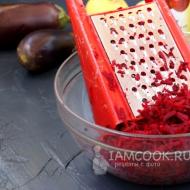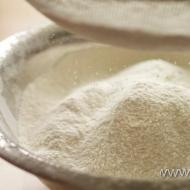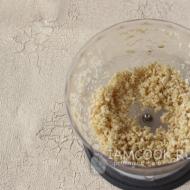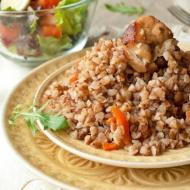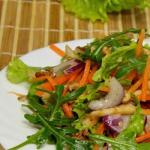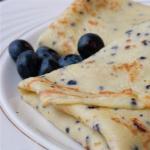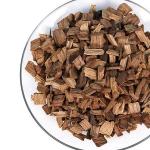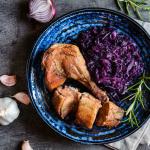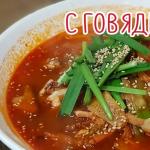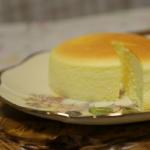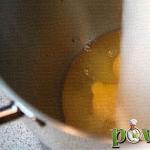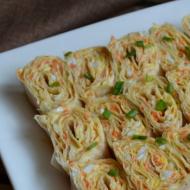
The most delicious dishes of Japanese cuisine. Japanese cuisine - recipe with photos. The most unusual food in Japan
Recently, many Russian tourists have visited Japan. They would probably like to surprise their loved ones with Japanese dishes. But often Japanese products are not available for purchase in our stores.
We wanted to show you a review of 10 Japanese food products that we can make ourselves at home!

There are many different liquid sauces and seasonings in Japan. The sesame dressing has a delicate balance of sweet, sour and salty, a little milky. The aroma of sesame seeds works wonders to whet your appetite. It is unlikely that you will find this gas station in local stores, but if you do, it will cost 2-3 times more than in Japan.
But you can do it yourself.
All you need are toasted sesame seeds, mayonnaise and rice vinegar (Japanese varieties are best), a pinch of sugar and salt. Mix everything until you get the taste you like. That's all!
Invite your friends!
Homemade TOFU

Bean curd - tofu - is recognized as the healthiest dish in the whole world. But in the West it costs on average about 400 yen ($4) - 4 times more expensive than in Japan. Why pay if you can do it yourself?!
Here are the instructions: www.culturesforhealth.com/how-to-make-tofu

http://www.youtube.com/watch?t=47&v=N0jZ61HLXVo
But fresh salmon is harder to find in Japan than in Western stores. Just sprinkle a little salt (2% of the weight of the fish), and keep it in the refrigerator for 2 days. It’s easy to prepare: boil, grill, fry for a few minutes. You can eat it whole, freshly cooked, cut it for a sandwich or for sushi, or break it into flakes for salad or onigiri (Japanese rice balls).
Dried mackerel
You can make it from fresh mackerel, mackerel, however, choose the fish yourself, according to your wallet and taste. You will need some salt and skewers for shish kebab.
Carefully remove the scales, cut the fish from the back, and remove the entrails. Then use a paper towel to blot any moisture from the fish. You need to sprinkle salt on both sides. Pass the kebab skewer horizontally through the fish and hang the fish outdoors in a well-ventilated place for the whole day. A little grilling and you have a great Japanese snack. And cooked at home!

Plum wine - umeshu - is one of the types of Japanese alcohol that can be easily prepared at home. You can buy it in a store, but many people are happy to make it themselves. You will need fresh plums, vodka and sugar. Wash and dry the plums. Place a layer of plums in a large jar and cover with sugar. Then add a second layer of plums and cover with sugar again. Pour in vodka and store airtight for 3 months. Plum fruits soaked in alcohol can also be eaten! Treat your friends!

Udon is a thick popular Japanese noodle. Actually, it is no different from our wheat noodles. The entire cooking process is up to your taste! Surprise your kids with noodles with any seasonings and sauces!
If you're a fan of traditional Japanese sweets, you'll be familiar with mochi. You can make it using regular potato starch. It's easy - watch the video.
Homemade miso 
Anyone who is interested in Japanese food knows about miso soup. But miso is also widely used in stews, stir-fries, and even grilled dishes. You need koji fermented rice. Well, then your imagination will tell you!
Japan has always been considered one of the most mysterious and attractive countries in the world for tourists. We know little about her cuisine, but we all know what sushi and rolls are.
Minimalism is the main criterion of the Japanese. The food they eat does not require special cooking or any processing. And if you are lucky enough to visit Japan, then visit not only the famous Mount Fuji, but also some local restaurant to try Japanese cuisine. And no matter what choice you make, check out 12 traditional Japanese dishes!
Dish No. 1. Sushi and rolls
It is not surprising that sushi and rolls are at the top of the list of traditional Japanese dishes. The proposal to visit Japan in order to try dishes whose recipes are known to every provincial chef seems strange. Today, in a restaurant with any cuisine, you can find “Gunkan-maki”, “California” and “Philadelphia” without applying for a visa or passport. The best taste can only be demonstrated by sushi and rolls with the freshest seafood, and these are served exclusively in Japan. Every restaurant has an aquarium or even a pond with live fish, which are caught directly to the table.
Dish No. 2. Ramen

The second place in traditional Japanese dishes is ramen. Thick soups are very popular in Asia: Thai soup Rad Na replaces the first and second courses at once. Japanese ramen is its close relative. It is sold by both street food vendors and fine dining restaurants. Ramen is a kind of assortment, because in its composition any component can be replaced with another. The basis is meat broth made from chicken, pork, and sometimes fish. Wide wheat or rice noodles are cooked in the broth, seasoned with eggs, green onions and seaweed. The skill of a ramen cook in Japan is measured by checking the texture of the meat in the soup: it should resemble puree.
Dish No. 3. Tempura

Another traditional Japanese dish rightfully occupies third position. Residents of the Land of the Rising Sun do not understand the popularity of American fast food - in particular, French fries. The Japanese found a recipe for a Lenten dish from Portuguese missionaries and made a cult out of it. In every home in the country you can find a special frying pan for tempura, which is taken out before parties and friendly get-togethers. Fresh shrimp, fish, vegetables and even fruits are fried in a small amount of oil. It is given a special taste by a batter made from eggs, ice water and flour, whipped until air bubbles form.
Dish No. 4. Okonomiyaki

The Japanese also found a replacement for burgers: they call it okonomiyaki, which means “flatbread with fish.” The base for the flatbread is grated cabbage or pumpkin, flour, cheese, egg and water. The ingredients are mixed and poured in a thin layer onto the pan to bake the pancake. The finished traditional Japanese dish okonomiyaki is soaked in thick soy sauce and sprinkled with chopped tuna flesh. The size and filling of the flatbread differs in each region of Japan: in Kansai they are much larger than in Tokyo.
Dish No. 5. Shabu-shabu

This traditional Japanese dish gets its name from a type of kitchen utensil. Shabu-shabu is a deep metal plate that can be heated in the oven or over an open fire. Broth with vegetables, tofu and noodles is poured into it. Served separately are sliced meats from duck, pork, lobster and chicken fillet: pieces of it are dipped into the heated broth immediately before consumption. Shabu-shabu is such a rich dish that it is served only in the cold season.
Dish No. 6. Miso

Miso soup is served as a side dish with any other dish except desserts. It is made from miso paste made from fermented soybeans and tuna dashi broth. This base mixture is supplemented with pieces of tofu, wasabi, onions, sweet potatoes, seaweed, carrots and radishes. It is never used as a main dish: miso is always served with at least one type of soup or two rice side dishes with different sauces.
Dish No. 7. Yakitori

The Japanese could compete with the Caucasian peoples for the right to be called the inventors of shish kebab. Since ancient times, they have fried meat over coals, stringing it on bamboo sticks. For Japanese kebab, both fillet and entrails are suitable, marinated in a mixture of rice wine, soy sauce, sugar and salt. When frying, the meat is poured with the same mixture, which is called “tare”. Yakitori is sold in small shops found on every corner. After finishing the working day, the Japanese do not consider it necessary to spend personal time preparing dinner: before returning home, they buy yakitori and beer or sweet carbonated drinks.
Dish No. 8. Onigiri

If yakitori is purchased instead of dinner, then for breakfast in Japan they order home delivery of such a traditional dish as onigiri. Rice balls filled with beans, shiitake mushrooms or pork in a variety of flavors are eaten as snacks, including during work breaks. In Japan, they are more popular than sushi due to the fact that their preparation does not require special skills. Girls prepare onigiri: they put rice and filling on their palm, and then roll the mixture into balls. In restaurants located in Tokyo, you can try a variety of onigiri called umeboshi - plum filling with salt and wine vinegar.
Dish No. 9. Soba

Wheat udon can be seen on the menu of any Asian country, so the Japanese decided to come up with their own variety of noodles. This traditional Japanese dish is made with buckwheat flour, which gives the pasta a grey-brown color. The soba is boiled, drained in a colander and mixed with vegetables and meat, separated into fibers. In small cafes and fast food establishments, soba is added to chicken broth to create an almost instant soup. Famous restaurants serve buckwheat noodles with crab and lobster.
Dish No. 10. Gudon

Translated from Japanese, this word means "bowl of beef." This spicy traditional dish, popular among Japanese men due to its high calorie content and satiety, is not inferior in spiciness to Thai culinary masterpieces. What distinguishes gyudon from soba is the amount of meat: when served, two or three spoons of rice and several handfuls of stewed meat with wine are placed on the plate. The top of the side dish is decorated with raw chicken yolk. Restaurants in the Japanese capital serve a type of gyudon - katsudon with a chop weighing at least 500 grams.
Dish No. 11. Yakiniku

Japanese men gather in groups and compete in the art of cooking grilled meat. The brazier is placed on a clay pot with hot coals. Each man has his own yakiniku recipe, which he does not share with anyone. In restaurants, this traditional Japanese dish is also prepared by a male chef using marbled beef of the highest category.
Dish No. 12. Suama

Desserts are not particularly popular in Japan, but neither adults nor children can resist suami. This cake is made from rice flour and fine cane sugar: the ingredients are ground in a mortar and pink dye is added. The color of sakura petals symbolizes this country, so cooks are prohibited from changing the color of the dye.
Don't miss interesting news in photos:


Household objects live their own lives
Unusual furniture that you want to eat
The best sweet gift ideas for the New Year 2019
Japanese cuisine or national cuisine of Japan can be described in just two words - exquisite beauty. The recipes for cooking dishes are quite simple and they are subordinated more to the external design of the dish than to complex and intricate technologies for creating one or another traditional dish. Heat treatment in creating Japanese culinary masterpieces is minimal. For example, traditional Japanese fish and seafood are often added raw to dishes.
Cooking traditional Japanese dishes is a real art, in which the cook, like a real artist, creates picturesque masterpieces. However, do not think that preparing national dishes at home is an impossible task. Everything is exactly the opposite. It’s not difficult to prepare Japanese food with your own hands, the main thing is to follow all the recipe instructions. If they are equipped with step-by-step photos, then even beginners in cooking will not experience any difficulties in creating Japanese dishes!
The basis of cooking in Japan is rice. In boiled, steamed, fried forms, it is consumed throughout the day (for breakfast, lunch and dinner). It was brought to the country in the second century BC. This culture became most widespread from the eighth to the twelfth centuries, becoming an integral part of the diet of the rich. A little later, rice entered the lives of ordinary people. By the way, there is an interesting fact in the history of Japan: rice became a kind of cement for uniting people into communities, since its cultivation was not an easy task, and therefore required joint efforts.

In addition to rice, in the ingredients of the dishes you will see all kinds of fish and seafood, which the coastal areas of Japan simply abound in! By the way, depending on the season, different types of fish can be eaten. The same applies to vegetables and fruits, which are also seasonal. A popular product is mushrooms, which are included in the recipes of many dishes. Meat is not readily consumed in Japan, which can be associated with the influence of Buddhism. History has even recorded facts prohibiting the eating of any living creatures.
In order for Japanese cuisine to bring only benefits, you need to be very careful when choosing products. Since there is practically no long-term heat treatment, they must be fresh. The Japanese themselves pay considerable attention to this, which is perhaps the most important secret of their delicious national cuisine!
The home menu of Japanese cuisine is quite varied. As we said earlier, rice is the basis of nutrition, and therefore it is present for breakfast, lunch and dinner. It is usually served with some kind of sauce. On the table it stands separately so that everyone can adjust the taste of rice at their own discretion. The morning meal is complemented by a first course, for example, Miso soup, fried fish, and vegetable salads. For lunch, the Japanese prefer main courses: noodles (udon, ramen or soba) or other main hot dishes made from fish or meat. For lunch, they most often eat Bento (in our understanding, this is an ordinary brake).
 Japan is most famous among gourmets for its cold appetizers: rolls and sushi. They are balls of almost unleavened boiled rice with a wide variety of fillings (fish, seafood, vegetables, tofu). Also, the components of these cold dishes may contain sheets of Nori seaweed. In general, sushi and rolls are approximately the same thing, with the only difference being that each sushi is made by hand, and the rolls are a kind of roll of nori, rice and filling, cut into pieces. These dishes are traditionally served with pickled ginger, wassabi, and soy sauce.
Japan is most famous among gourmets for its cold appetizers: rolls and sushi. They are balls of almost unleavened boiled rice with a wide variety of fillings (fish, seafood, vegetables, tofu). Also, the components of these cold dishes may contain sheets of Nori seaweed. In general, sushi and rolls are approximately the same thing, with the only difference being that each sushi is made by hand, and the rolls are a kind of roll of nori, rice and filling, cut into pieces. These dishes are traditionally served with pickled ginger, wassabi, and soy sauce.
Both traditional and modern Japanese cuisine is famous for its tea ceremonies. This is a real ritual, with many strictly defined procedures, subject to quite a large number of various rules. In general, tea in Japan is a fairly popular drink. As for alcoholic drinks, the most famous and revered is sake or rice vodka.
 And to top off all of the above, we would like to draw attention to such a feature of real Japanese cuisine as table setting. It has a special place in the culture of food consumption. For example, all dishes have a strictly defined place on the table. In addition, everything should look aesthetically pleasing. This is very important for the Japanese! So we can conclude that not only the preparation of food is subject to rather strict requirements, but also its serving.
And to top off all of the above, we would like to draw attention to such a feature of real Japanese cuisine as table setting. It has a special place in the culture of food consumption. For example, all dishes have a strictly defined place on the table. In addition, everything should look aesthetically pleasing. This is very important for the Japanese! So we can conclude that not only the preparation of food is subject to rather strict requirements, but also its serving.
In general, if you want to master all the nuances and subtleties of traditional Japanese cuisine, then we suggest you study the photo recipes that are given in this section. They are not just general descriptions and cooking recommendations, but real master classes with step-by-step photos. Of course, you can get acquainted with the national cuisine of Japan in cafes or restaurants, but it is much more interesting to eat some Japanese dish prepared with your own hands. So go for it!
Everyone knows that the Japanese are the healthiest and longest-living nation in the world. This is a great merit of traditional cuisine, which gives preference to natural products with a minimum of processing. So what do the Japanese eat in everyday life?
Many people mistakenly believe that the Japanese eat exclusively sushi and rolls. In fact, their diet is quite varied:
- Fish: tuna, salmon, mackerel, sea bass, eel, sea bream, fugu and many others.
- Seafood: octopus, mussels, shrimp, scallop, sea urchin, squid, crab.
- Rice. The Japanese call it "Gohan".
- Soybeans and products made from it: miso, tofu, natto, soy sauce.
- Noodles: udon (wheat flour without eggs), ramen (egg and wheat flour), soba (buckwheat flour), rice noodles (rice flour), glass noodles (bean starch).
- Beans.
- Seaweed.
- Meat: beef and pork
- Vegetables: cucumbers, carrots, cabbage, sweet potatoes, daikon, ginger, asparagus, bamboo shoots.
The Japanese, unlike other Asian peoples, prefer to emphasize the natural taste of food in their cuisine. Therefore, they use few seasonings, practically do not fry, and eat many foods raw.
Table setting and food culture occupy a very important place in Japanese cuisine. The Japanese eat with chopsticks, all dishes are served in small portions in a certain order. There are rules for how to eat this or that dish.
Europeans often wonder why the Japanese don't eat with forks. This is due to the fact that chopsticks (called “hashi” in Japan) appeared in Asia much earlier than other cutlery. Initially, chopsticks were used only for cooking, and people ate with their hands. The Japanese have been using hashi for food for thousands of years. In addition, the sticks are made from natural materials. Since they can capture a small amount of food, it promotes better digestion.
In Japan, it is believed that there should be three meals and each of them must include rice.
What do the Japanese eat for breakfast?
Modern Japanese often eat European cuisine, including for breakfast. But a traditional Japanese breakfast consists of:
- Boiled rice and natto. Natto is a type of soybean that is seasoned with sauce and placed on top of rice. Since natto is very rich in vegetable protein and satisfies hunger for a long time, this dish is popular for breakfast.
- Tamago-yaki is an omelette rolled into a roll. Tamago-yaki differs from the usual omelette in that a little soy sauce with added sugar is poured into it.
- Misoshiru is a soup made from miso bean paste. To prepare it, soy cheese tofu, wakame seaweed and other ingredients are used. The composition of the soup largely depends on the season and region of residence of the Japanese.
- Tsukemono – pickled vegetables. Each type of vegetable has its own pickling method. Since vegetables are not heat-treated, they retain all their beneficial substances. Nowadays, much less salt is added to tsukemono than before.
- Tea. Most people in Japan drink green tea. Not a single meal is complete without tea.
Despite the variety of dishes, they are served in very small quantities. It is noteworthy that the Japanese practically do not eat bread and butter, even for breakfast. Soy products are very nutritious and provide long-lasting energy.

What do the Japanese eat for lunch?
The Japanese prefer light lunches. Its basis, of course, is rice. It is served with fish, which can be raw, grilled or marinated. Boiled vegetables or salads can complement lunch. Rice vinegar or soy sauce is used as a dressing in salads. I almost never use mayonnaise in traditional cuisine. At the end of lunch they drink tea.
Nowadays Western influences are increasingly felt in Japan. That's why you can often find young Japanese people eating fast food.

What do the Japanese eat for dinner?
The Japanese eat dinner quite heavily. Standard dinner includes:
- Rice or noodles.
- Soup. The Japanese love soups very much. The most commonly prepared dishes are misoshira and suimono (clear soups). They can be fish, meat, vegetables. For most soups, all ingredients and broth are boiled separately and combined only before serving. It is noteworthy that the Japanese eat soups with chopsticks, first catching pieces of vegetables and meat. Then drink the broth directly from the cup.
- Meat or fish in any form.
- Vegetables that can be steamed.
- Pickled snacks - tsukemono.
- A dessert made from traditional Japanese sweets called wagashi. There are many varieties of wagashi. To prepare them, rice or legumes, sweet potatoes, gelatin, chestnuts, herbs and fruits are used. They have a specific taste and are absolutely different from European sweets.
- Green tea.
Of course, the Japanese menu depends on personal preferences and family customs.
The article talks about what the Japanese usually eat for breakfast, lunch and dinner, what dishes are most popular and what products are used to prepare them. Some traditions associated with eating are also described.
Japanese cotton cheesecake in a slow cooker is a new trendy recipe for a curd dessert. It is not called cotton by chance, but because of its delicate structure. In many foreign cuisines, delicate baked goods are compared to the finest fabrics, calling, for example, a sponge cake - chiffon, and a cheesecake - cotton. The Japanese cheesecake, the recipe for which you see on this page, is easy to bake, although you need to follow some...
No reviews Read 906 times(a).
Miso soup is a favorite among many when visiting Japanese restaurants. The taste, unusual for Europeans, and beautiful design may make you want to cook something similar at home. In fact, there is nothing difficult in preparing Japanese cuisine at home: most Japanese dishes are prepared quickly and are a little undercooked at the outside glance. Although modern cooking is adopting...
No reviews Read 1653 times(a).
Here I will tell you how to cook rice as a side dish by adding various vegetables to it: green peas, mushrooms, cabbage, onions, carrots, etc. In fact, I tried to cook delicious rice as a side dish in a slow cooker with a variety of vegetables. I think you should definitely put only carrots and onions. The rest of the vegetables can be added as desired and available in the refrigerator - a variety of them. I seasoned boiled rice as a side dish...
No reviews Read 1651 times(a).
Fried flounder, the recipe for which is described below, is a delicious combination of fish and vegetables. Fish protein brings great benefits to the body, plus a whole bunch of important vitamins (vitamin P, more than the daily requirement of vitamin B12, etc.). In addition, cabbage and peppers, in addition to valuable fiber, will provide us with ascorbic acid, which is especially important for the heart and blood circulation. This recipe uses Far Eastern spicy...
No reviews Read 1539 times(a).
Today I’ll tell you how to deliciously cook beef in a slow cooker with red wine vinegar, Tamari sauce and seasonings. You can use soy sauce instead of Tamari - the two sauces are very similar: Tamari is the Japanese version of Chinese soy sauce. It is also prepared on the basis of soy, but it is less salty and thicker and more aromatic than soy. For this slow cooker beef recipe, the slow setting is ideal...
No reviews Read 5222 times(a).
Chicken with pineapple in a slow cooker is a dish that has become popular recently. It is better to use canned pineapples, although fresh ones are also possible. Chicken with pineapples can be prepared for the New Year or other holiday or special occasion. This will bring a little tropical mood to our winter holiday. In addition, we will add teriyaki sauce, popular in Far Eastern cuisine, to the pineapples. How...
No reviews Read 2879 times(a).
Cabbage casserole in a slow cooker, prepared according to a Japanese recipe - layers of cabbage leaves - is an absolutely amazing dish. It looks like a cake and tastes like cabbage rolls. This recipe is very popular in Europe and America, but it came there from Japanese cuisine. I don’t know about you, but I really love cabbage in any form: I often cook Ukrainian cabbage, cabbage rolls in a slow cooker, Russian cabbage soup made from sauerkraut...
2 reviews Read 5871 times(a).
Chicken in teriyaki sauce, the recipe for which you are reading, is a common dish in Japanese restaurants. It is slightly adapted for Western consumers, but in general, it retains the peculiarity of teriyaki cooking. In Japanese, it means a sauce made with sugar and rice vinegar, which is fried until the sugar caramelizes, giving it a certain shine. "Teri-yaki" is Japanese and means "shiny sauce." IN...
No reviews Read 1273 times(a).


